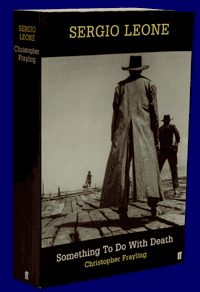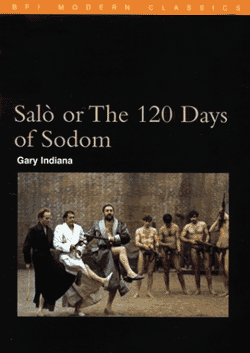IN PRINT
Salò or The 120 Days of Sodom | Sergio Leone | Thirty Frames Per Second
By Gary Indiana
BFI Publishing, $10.95, paperback, 96 pages
Pier Paolo Pasolini’sSalòor The 120 Days of Sodom is a film people love to hate. Aesthetic conservatives see its elegant rituals of torture and rape as gratuitous and immoral. A French journalist even suggested that it be entered as a defense exhibit at the trial of Pasolini’s murderer. Others, like Gary Indiana in his recent monograph on the film for the BFI Modern Classics series, stress the affection in their aversion. "Salò is one of those rare works of art that really achieves shock value," he writes, defining the film’s cultural usefulness.
As a novelist himself, Indiana – faintly echoing the recent Eminem controversy – treasures such unbridled intellectual honesty: "I should be able to kill everyone I don’t like in a novel and get away with it, rape a 12-year-old and piss on my father’s grave." Such unpleasant dramas can, as with Salò, reflect back to us the painful contradictions of our own society. Although the conventional, and sympathetic, gloss reads the film as an antifascist fable, Indiana pushes for a more relevant read. For him, it is an allegory of a late-capitalist market economy, "where a limitless choice of gratifications disguises an absence of all choice and all resistance, where nothing can disrupt the smooth operation of a system that turns art into products and people into things."
Produced in 1975 as an adaptation of the Marquis de Sade’s 120 Days of Sodom, Salò was both the last part of – and a sharp departure from – Pasolini’s literary cycle, which included adaptations of Boccaccio’s Decameron, Chaucer’s Canterbury Tales, and The Arabian Nights. Unlike the ribald, playfully erotic tenor of those other films, Salò is from the start a tale of woe. Transplanting Sade’s tale to the countryside of fascist Italy, the film unfolds as four men of power (a duke, a banker, a judge and a monsignor) send their henchman to capture beautiful young boys and girls from the neighboring towns and bring them to their châteaux so they can subject them to a series of increasingly more grotesque acts. Not unlike Dante’s infernal geography, Salò divides its drama into a series of circles: "The Circle of Obsessions," filled with rape and perversity; "The Circle of Shit," which concludes with a grand feast of feces; and finally "The Circle of Blood," in which torture and murder kill the story off.
Obviously, the movie has few immediate pleasures. Even Indiana’s own personal recollection of the film – pooled together in a muddy memory of work and Hollywood S&M clubs in 1977 – was of "another little patch of soft, crumbly alienation and waking dream." As such, this monograph does not come across as a loving compendium of facts and anecdotes; rather, the film is for Indiana like an itch that he must scratch until he has laid bear the raw, irritated essence of its being. As Indiana describes it, "In Salò, I think, [Pasolini] hit a nerve that hasn’t gone numb since the film first appeared."
Indiana creates an interpretative archeology, sifting and sorting, using autobiography and critical analysis, providing a plot digest as well as summaries of auteur and queer theory and précis of Italian history and politics. In the end, however, Indiana arrives at the point that the film has less a meaning than an effect: "Its power to disturb something buried very deep in each of us is beyond question. Salò is the very model of life as most have it in the 20th century, a metaphor of feudalism as reinvented by the multinational corporation." Happy viewing. – Peter Bowen
 Sergio Leone: Something to Do With Death
Sergio Leone: Something to Do With Death
By Christopher Frayling
Faber and Faber, $20, paperback, 570 pages
Christopher Frayling’s Sergio Leone is a fat trove of chronology and miscellany, both pragmatic and mytho-poeticizing. (Make the great films, but have a better idea of what can make a great life.) Late in his career, after the decade-and-a-half struggle to put Once Upon a Time In America up on screen, Leone continued to chat up vast and vastly ambitious projects – Frayling describes the garrulous man’s 1980’s "party piece" as a fact-shredding prologue to a never-written epic, The Siege, about the Siege of Leningrad: "Was he playing out an elaborate game," Frayling asks.
While Orson Welles was often thought of as a man who had given up on work, fresh script pages were at his desk the day he died. Leone was another case. "You can’t shoot film as if you were putting salami into its skin," he rationalized. "I do not work so much at the moment through philosophical choice, because I do not want to die with my eyes glued to the viewfinder." Leone’s health finally caught up with him in 1984; a heart condition stalled him and he died five years later.
Frayling’s book, an epic tome that feels as if it could have been even longer, compresses Leone’s early years and dives quickly into his apprenticeship in sword-and-sandal epics, his work under visiting American directors at the Cinecitta studios, the likes of Fred Zinneman and Robert Wise. Soon he was making his own pulp "peplum" pictures, which he would disdain later, saying that all his pre-Fistful of Dollars work was made "for bread and butter, to pay for my honeymoon in Spain." Abundant detail is the greatest virtue of this studious catalogue of a book. The detailing of script conferences, such as with Bertolucci and Dario Argento on Once Upon a Time in The West, is valuable, describing Leone’s archeological, almost pathological obsession with telling details in the research and writing process.
While it took 15 years to assemble the script and production of Once Upon a Time In America, it was the apotheosis of his lifelong project to confect enchantment, to find truth through the embellished and the extravagant, one of the grand strains of mannerism Italian directors have brought to cinema. As a businessman, he made bravura deals to shoot bravura commercials, procrastinating as baroquely as he directed. Yet the lessons to take away from the labor of both book and life are simple and sometimes stark, such as Argento’s nod to the simplicity of Leone’s excess: "From Sergio I learned the cinema can basically be time and rhythm." For a few zooms more .... – Ray Pride
Thirty Frames Per Second: The Visionary Art of the Music Video
By Steven Reiss and Neil Feinman
Harry N. Abrams, $39.95, 272 pages
From the time Marcel Duchamp scrawled "R. Mutt" on a porcelain urinal to the writings of the Cahiers du Cinema critics, who valorized American genre movies over France’s "cinema of quality," and on through the various forms of Warholian pop, the boundaries between high and low art have been elided in the 20th century. And with the Fluxus movement and conceptual performance art of the late 1960s and ’70s doing away with the one value – permanence – clung to by high-art diehards, today, with few exceptions, only conservative talking heads like William Bennett even deem the high/low culture question worthy of debate.
Two exceptions from the other side of the table are Steve Reiss and Neil Feinman, authors of Thirty Frames Per Second: The Visionary Art of the Music Video, a lavishly produced paean to music video that is half overheated cultural defense and half résumé book of the medium’s most celebrated practitioners.
Designed by Steve Tolleson, the large-format book is importantly sandwiched between translucent plastic covers. Organized around the concept of the auteur, the book’s copy consists primarily of short bios and appreciations of 60 or so of today’s top directors (Jonas Akerlund, Chris Cunningham, Tamra Davis, Jonathan Glazer, Jake Scott, Hype Williams, David Fincher, Floria Sigismondi, etc.) juxtaposed with stills and screen-captures from their videos.
The book looks great, even if its attempt to create a sophisticated print montage from its video-image source material foregrounds its own design over the reader’s apprehension of the visual ideas of the videos themselves. And the authors’ alphabetical organization of their director profiles allows them to pass on the kind of critical correspondences and summaries one would expect in such an undertaking.
More problematic is the book’s 30-page intro, which bookends a mostly accurate retracing of music video’s origins (citing such early examples as Richard Lester’s Beatles films and Captain Beefheart’s famous TV commercial for his Warner Bros. release, "Lick My Decals Off, Baby") with defensive-sounding proclamations of the form’s worth. John Barth is quoted in the book as saying that postmodern literature "must be democratic, accessible and able to be reread" with enjoyment, but unlike the authors, I’m not sure Barth would have willingly transposed the object of his commentary to music video.
The authors awkwardly defend video from frequent attacks by film critics – who assert that videos promote short attention spans, style over substance, and contain little narrative or character development – by citing "those pesky surrealists and Dadaists ... not to mention novelists like Joyce, Dos Passos, Pynchon and DeLillo," who presumably mounted a similar attack on traditional literature.
Stranger still, for a book that seems obsessed with music video’s place in history, Thirty Frames Per Second is so stuck in the present that it contains little or no mention of truly relevant artists such as Kenneth Anger, Bruce Connor, Nam June Paik, or other significant early music-video pioneers, including Julien Temple, Zbigniew Rybczynski, The Residents and Jeff Stein, among others.
There are passages sprinkled throughout the book – an irreverent chart outlining the video commissioning process; Garbage vocalist Shirley Manson’s notes to director Matthew Rolston on his director’s cut of "Paranoid" – that point toward what this book might have been. Although the elegant design and feel of the book will shine the egos of those within the industry itself, the rest of us might have wished for something just a couple steps to the right of VH1’s Pop-Up Videos – namely, a book that delighted in highlighting the visual invention, cultural trend-spotting and calculated exuberance found in the best examples of the music-video genre. – Scott Macaulay
VOD CALENDAR


 See the VOD Calendar →
See the VOD Calendar →



